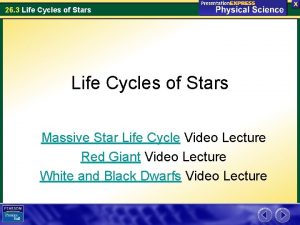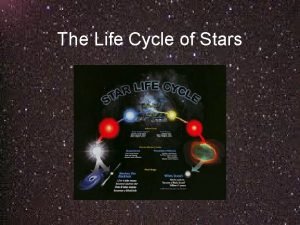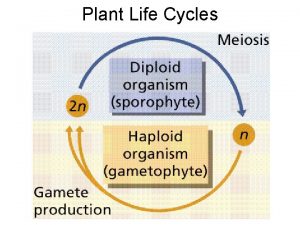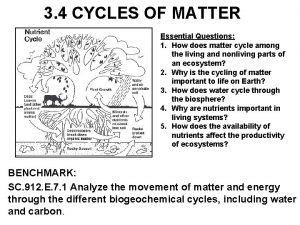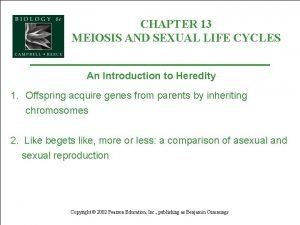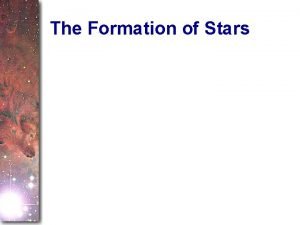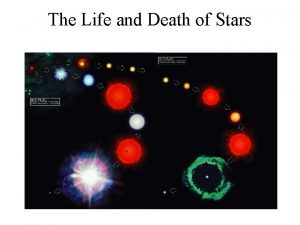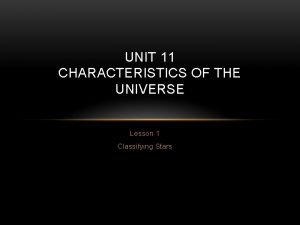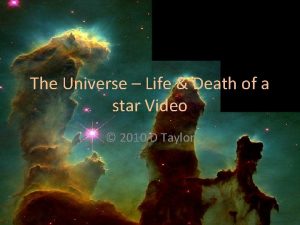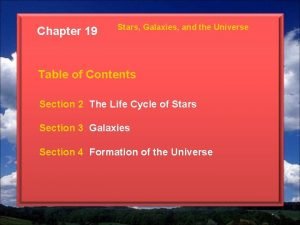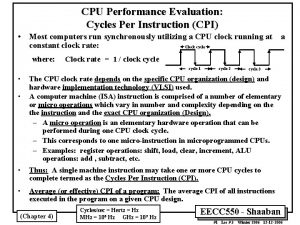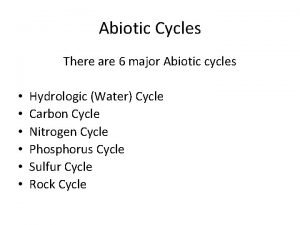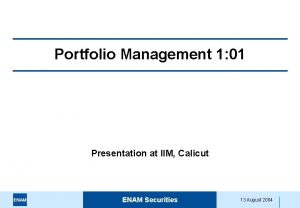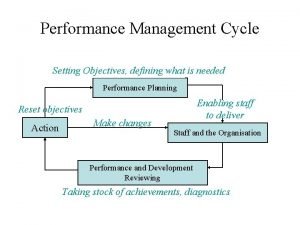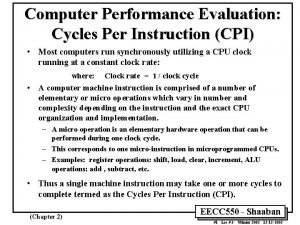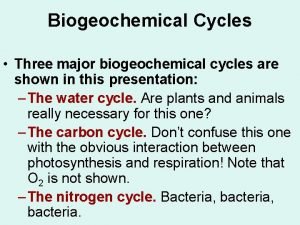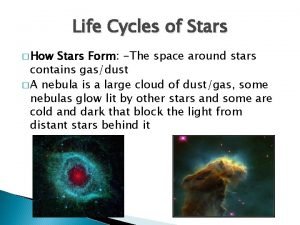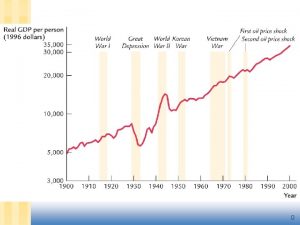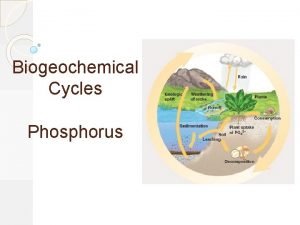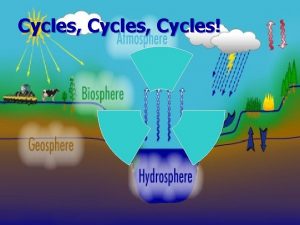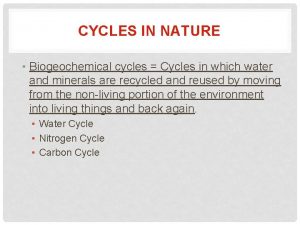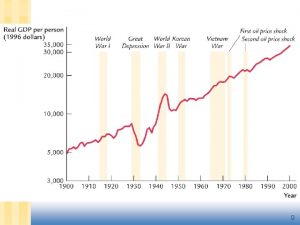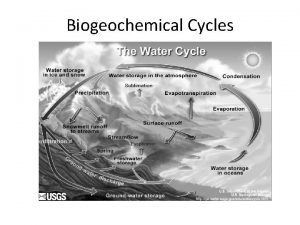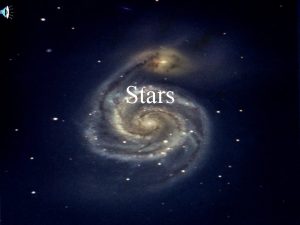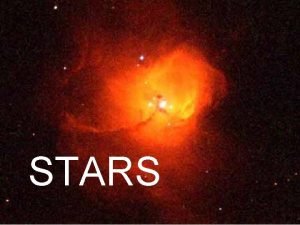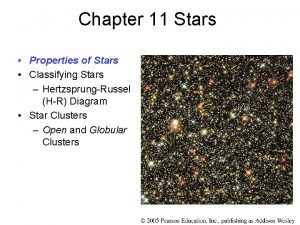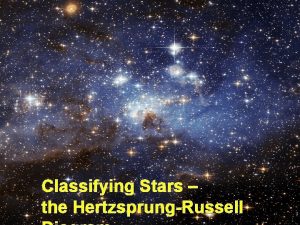Outline Introduction The Life Cycles of Stars The


















































- Slides: 50


Outline Introduction The Life Cycles of Stars The Creation of Elements A History of the Milky Way Nucleosynthesis since the Beginning of Time

INTRODUCTION íAbundances of the elements íComposition of stars íHow do we learn what stars are made of?


The Composition of Stars 90% hydrogen atoms 10% helium atoms Less than 1% everything else M

Finding the Composition of a Star Rainbows from starlight

The Solar Spectrum – In Detail!

Stellar Spectra

Abundances of the Elements

Solar Abundances EXPANDED

The Life Cycles of Stars • Fundamental Properties of Stars – – Mass Temperature Luminosity or radius Age • Star Birth • Middle Age • Stellar Senior Citizens

But only certain sizes and colors are allowed! Stars come in many sizes and colors

The Main Sequence The sun is an ordinary, yellow main sequence star

Giants are cool and very large

Most stars occur in these main groups in the luminosity-temperature diagram ð Main Sequence ð Giants ð Supergiants ð White Dwarfs

Quiz: Which star is the biggest? ðA ðB ðC ðD

Quiz: Which star is the smallest? ðA ðB ðC ðD

The Evolution of Stars

The Ages of Stars

How old is the Jewelbox? ð The Jewelbox Cluster is about 12 million years old

Star Birth • New stars are born continuously • Stars form in dense regions of gas and dust

Stellar Middle Age Stars produce energy by converting hydrogen into helium through nuclear reactions in their interiors.

The Proton-Proton Cycle Stars produce energy by fusing hydrogen nuclei into helium, and helium into heavier nuclei

Stellar Senior Citizens When stars finally deplete their nuclear fuel, they become white dwarfs, neutron stars, or black holes. In the process, much of the stellar material is returned to interstellar space

The Creation of Elements… “Just between you and me, where does it get enriched? ”

Primordial Nucleosynthesis Hydrogen and helium were created during the Big Bang while the Universe was cooling from its initial hot, dense state. About 10% of the lithium in the Universe today was also created in the Big Bang. We’re still not sure where the rest comes from.

Hydrogen Burning Stars burn hydrogen in their interiors to produce helium. Hydrogen burning also rearranges carbon, nitrogen, and oxygen.

Helium Burning Three helium atoms combine to form carbon

Alpha-Process Elements Carbon and oxygen atoms combine to form elements with even numbers of protons. These elements come from supernovae.

The Iron Peak Metals In the cores of massive stars during supernova explosions, atomic nuclei exchange protons and neutrons to form the iron peak metals.

Heavy Metals All heavier elements are formed when iron peak elements capture neutrons

Heavy Metals from Ancient Superstars ï Some heavy metals are made in supernovae when massive stars explode ï The explosion produces many free neutrons, which combine with iron to make heavier metals

Making Heavy Metals in Low Mass Stars • In low mass stars like the sun, neutrons are created when protons mix into the hot, helium-burning region • With only a few neutrons available, a different set of heavy metals are created

Neutron Capture Elements in the Solar System Purple elements were formed By studying the abundance patterns in the supernovae (the r-process) and of heavy metals, we can learn pink elements were formed whether the metals were madeinin red giant stars (themass s-process) supernovae or in low stars.

A History of the Milky Way What is a galaxy? Structure of the Milky Way How did our galaxy form? You are here.

The Milky Way…. Halo Flattened Inner Halo Disk Bulge Thick Disk Dwarf Spheroidal Companions Dark Matter Corona

Formation of the Milky Way Galaxy Collisions and Mergers

Chemical Evolution ï The creation of elements in stars leads to chemical enrichment of the Galaxy ï The composition of the Galaxy depends on ï How fast stars form ï What kinds of stars form ï How long it’s been since stars started to form

The Chemistry of Stars The chemical compositions of stars reflect the star formation histories of stellar populations The complexity of the Milky Way’s history is reflected in the compositions of its stars

Heavy Metals in the Early Galaxy ï In the early galaxy, elements were forming very quickly from new star formation. ï The chemical mixture we see is different from the Solar System ï We find a much smaller amount of “metals” mixed in with the hydrogen and helium ï Heavy metals come only from supernovae – not from low mass stars

Nucleosynthesis Since the Beginning of Time • By studying stars of different ages, formed at different times in the Galaxy’s history, we can trace the history of the Milky Way

Low Mass Stars Begin to Contribute Heavy Metals Low mass stars begin to contribute heavy metals when the Galaxy reaches an age of a few hundred million years.

The Mystery Metals The abundances of the “light” heavy metals in ancient stars are too high to explain with our current theory of supernova r-process production

Where to the first metals come from? Ancient Superstars! ï Formation of stars as “pre -galactic” objects from small density fluctuations ï Masses from a few tens to a few hundred solar masses ï Low mass star formation is suppressed because the first, massive stars reheat the gas ï These stars form the first metals

Metals in Very Distant Galaxies ï Studies of the most metal-poor stars in the Galaxy give us access to the state of the Universe at very early times The most metal-poor stars in our Galaxy contain only 1/10, 000 of the amount of metal that the sun has. The most distant galaxies we can study contain 1/100 (1%) of the amount of metal that the sun has

The Epochs of Galactic Chemical Evolution í Primordial Epoch -The Big Bang (hydrogen, helium, lithium) í Epoch of Massive Stars – the first few million years ï Ca, O, and the “mystery metals” í Supernova Epoch - r-process elements from 8 -10 M Sun SNII í The first few 10’s of millions of years í The Red Giant Epoch yields s-process elements í The first few hundreds of millions of years í The Iron Epoch – most of the iron comes from low mass stars í The first billion years í The Lithium Epoch – Where does lithium come from? ?


Websites of Interest ï Jewels of the night ï http: //www. noao. edu/education/jewels/home. html ï National Optical Astronomy Observatory Image Gallery ï http: //www. noao. edu/image_gallery ï Space Telescope Science Institute ï http: //www. stsci. edu ï Amazing Space ï http: //amazing-space. stsci. edu ï NASA’s Astronomy Picture of the Day ï http: //antwrp. gsfc. nasa. gov/apod/astropix. html ï Astronomical Society of the Pacific ï http: //www. astrosociety. org ï The Stonebelt Stargazers ï http: //www. mainbyte. com/stargazers/


n-capture Synthesis Paths La Ba 138 139 p s, r 130 132 134 135 136 137 138 p p s s, r 133 Cs Xe s, r 128 129 130 131 132 134 136 s s, r r r s-process path r-process path
 Life cycle of a star assessment
Life cycle of a star assessment Life cycles of stars
Life cycles of stars There are millions of stars in the sky
There are millions of stars in the sky Nitrogen cycle poem
Nitrogen cycle poem Rvguev
Rvguev Kiwi bird life cycle
Kiwi bird life cycle Fadlife
Fadlife Plant life cycles and alternation of generations
Plant life cycles and alternation of generations Fungal life cycles
Fungal life cycles виды проектов
виды проектов Matter cycle
Matter cycle Chapter 13 meiosis and sexual life cycles
Chapter 13 meiosis and sexual life cycles Stars outline
Stars outline What is the life cycle of a small mass star
What is the life cycle of a small mass star Life cycle of a star notes
Life cycle of a star notes The life and death of stars
The life and death of stars H
H Life cycle of stars graphic organizer
Life cycle of stars graphic organizer Where does joshua barnes think they come from
Where does joshua barnes think they come from Chapter 19 section 2 the life cycle of stars answer key
Chapter 19 section 2 the life cycle of stars answer key Stellar evolution lab the life cycle of a star
Stellar evolution lab the life cycle of a star Example of sentence outline about education
Example of sentence outline about education Mandarin cycles
Mandarin cycles Importance of water cycle
Importance of water cycle Pdsa cycle nursing
Pdsa cycle nursing Precession milankovitch cycles
Precession milankovitch cycles Transaction cycle flow chart
Transaction cycle flow chart Cpi cycles per instruction
Cpi cycles per instruction Biogeochemical cycles water cycle
Biogeochemical cycles water cycle Apes cycles
Apes cycles What is the major abiotic reservoir for phosphorus
What is the major abiotic reservoir for phosphorus Biogeochemical cycle quiz
Biogeochemical cycle quiz Cycles in nature
Cycles in nature Joke cycles
Joke cycles Joke cycles
Joke cycles Biogeochemical cycles class 9 ppt
Biogeochemical cycles class 9 ppt Fatigue risk assessment matrix
Fatigue risk assessment matrix Cell cycle foldable project
Cell cycle foldable project Design science research cycles
Design science research cycles Compare and contrast carbon and nitrogen cycles
Compare and contrast carbon and nitrogen cycles Biogeochemical cycles poster project examples
Biogeochemical cycles poster project examples Apa itu pdsa
Apa itu pdsa Alphonse mucha advertisements
Alphonse mucha advertisements Management performance cycle
Management performance cycle Water cycles of matter
Water cycles of matter Isagenix presidents pack
Isagenix presidents pack Multiplication of cycles
Multiplication of cycles Cpi cycles per instruction
Cpi cycles per instruction Diurnal tide cycles occur ______.
Diurnal tide cycles occur ______. 4 major biogeochemical cycles
4 major biogeochemical cycles Pearson education
Pearson education
